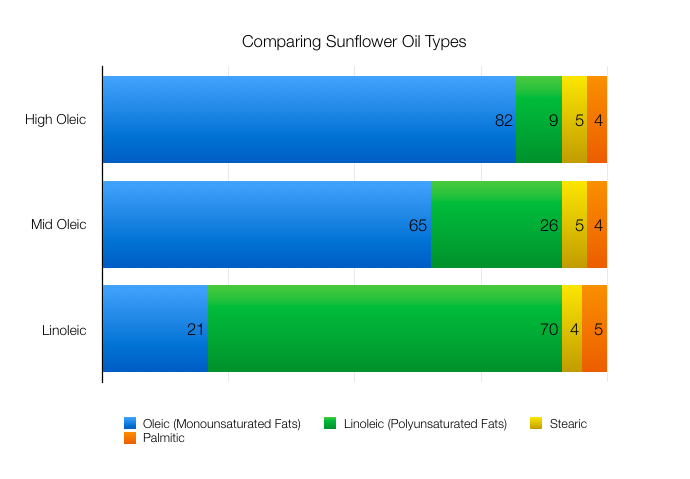
What do you mean different types of sunflower oil? I thought there was just one -- sunflower oil!
There are, in fact, a number of different types of sunflower oil. The types (or grades) are differentiated based on what type of fat makes up the oil, as well as how the oil was produced.
Sometimes it is hard to know exactly what kind of oil will work best for you and your product lines. If you're in the R&D stages of new product development, you will be faced with decisions about choosing the the right ingredients. Let's pretend you have finally made the decision to use Sunflower Oil. You will next be immediately be presented with the next question: What kind of Sunflower Oil would you like?
Sunflower Oil is a type of seed oil that comes in a few different varieties. There are three main types: high oleic, mid oleic, and linoleic.
The Differences Between High Oleic, Mid Oleic and Linoleic Sunflower Oil
The difference between each type/grade of sunflower oil is a result of the balance between the different types of fats that make up the oil.
With sunflower oil, we are primarily comparing the balance between it's two most prevalent fat types: polyunsaturated and monounsaturated fat. Polyunsaturated fats can be equated to linoleic acid and monounsaturated fats can be equated to oleic acid -- it just depends on who you are talking to, so it's important to understand that these terms may be used interchangeably.
Each sunflower grade differs in the overall oleic and linoleic chemical levels in the oil, as a result of the type of seeds that are grown.
The most healthy of the three would be high oleic oils. This is due to the fact they have the most monounsaturated fat that makes up the oil. Linoleic is comprised of more polyunsaturated fats (which are considered less healthy) and mid-oleic falls somewhere in between.
Here is a chart that shows typical fatty acid profiles of each type of sunflower oil.

Linoleic Sunflower Oil
Traditional sunflower oils have fallen into two categories: one high in oleic acid and the other high in linoleic acid. We are going to first approach the oil that's high in linoleic acid.
Linoleic acid is one of the essential fatty acids in the human diet. Linoleic varieties of sunflower oil contain nearly 70% polyunsaturated fat, another 20% is in monounsaturated fat, and the remaining 10% - 11% is saturated fat.
Linoleic sunflower oil is considered one of the least healthy types of sunflower oil, in comparison the high oleic oils that contain more healthy fats.
This oil is now produced in very small quantities in North America, because of it's limitations in fried foods. It is, however the traditional type of sunflower oil that's been produced for many years and is still very common outside the US.
Mid-Oleic Sunflower Oil
The mid-oleic sunflower oil takes a middle position between the two traditional oils, with oleic acid accounting for roughly two-thirds of the fat content, polyunsaturated linoleic acid at roughly 25%, and about 10% saturated fat. Mid-oleic oil retains high enough levels of linoleic acid to remain an excellent dietary source, but the relatively high levels of oleic acid make it less prone to rancidity and breaking down/eliminating any need for hydrogenation and the resulting trans fat. It is most often a solvent expelled oil.
High Oleic Sunflower Oil
This oil is radically different than linoleic in its makeup and consists primarily of monounsaturated fat at 80% of the total. Saturated fats and polyunsaturated fats make up the balance in equal proportions.
High oleic sunflower oil in bulk is important in the manufacturing of food products because it remains stable without hydrogenation and will not go bad when storing long-term. This makes switching from bulk linoleic to high oleic sunflower oil an easy way for manufacturers to reduce their unhealthy fats and increase their shelf life limitations.
This high oleic sunflower oil is preferred by food manufacturers nationwide because of it's added stability and neutral taste profile. It's an ideal oil for frying, baking and other high heat applications. High Oleic sunflower oil can be produced through expeller pressing methods or solvent extraction. Make sure that you confirm which type you are looking for with your supplier.
Natural food manufacturers prefer high oleic sunflower oil because it is often expeller pressed and have many of the healthier qualities that make it popular with their target market.
Naturally Non-GMO
All types of Sunflower Oil are naturally non-GMO. There are no GM varieties available, making this a low-risk ingredient if you are planning on getting your product Non-GMO Project Verified.
Topics: Sunflower/Safflower Oil












